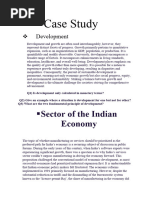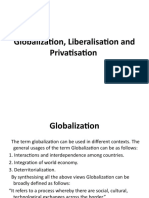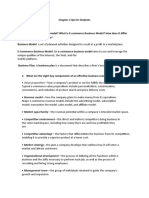0 ratings0% found this document useful (0 votes)
11 viewsChapter One-Introduction
Chapter One-Introduction
Uploaded by
Taye demereThis document discusses the history and role of public enterprises in developing countries. It covers three periods: pre-independence under colonial rule, post-independence growth of public enterprises as a development strategy, and reforms beginning in the 1980s under structural adjustment programs. The document provides context on changing economic philosophies and the rationale for governments' involvement in public enterprises.
Copyright:
© All Rights Reserved
Available Formats
Download as PPT, PDF, TXT or read online from Scribd
Chapter One-Introduction
Chapter One-Introduction
Uploaded by
Taye demere0 ratings0% found this document useful (0 votes)
11 views19 pagesThis document discusses the history and role of public enterprises in developing countries. It covers three periods: pre-independence under colonial rule, post-independence growth of public enterprises as a development strategy, and reforms beginning in the 1980s under structural adjustment programs. The document provides context on changing economic philosophies and the rationale for governments' involvement in public enterprises.
Original Title
1. Chapter One-Introduction (2)
Copyright
© © All Rights Reserved
Available Formats
PPT, PDF, TXT or read online from Scribd
Share this document
Did you find this document useful?
Is this content inappropriate?
This document discusses the history and role of public enterprises in developing countries. It covers three periods: pre-independence under colonial rule, post-independence growth of public enterprises as a development strategy, and reforms beginning in the 1980s under structural adjustment programs. The document provides context on changing economic philosophies and the rationale for governments' involvement in public enterprises.
Copyright:
© All Rights Reserved
Available Formats
Download as PPT, PDF, TXT or read online from Scribd
Download as ppt, pdf, or txt
0 ratings0% found this document useful (0 votes)
11 views19 pagesChapter One-Introduction
Chapter One-Introduction
Uploaded by
Taye demereThis document discusses the history and role of public enterprises in developing countries. It covers three periods: pre-independence under colonial rule, post-independence growth of public enterprises as a development strategy, and reforms beginning in the 1980s under structural adjustment programs. The document provides context on changing economic philosophies and the rationale for governments' involvement in public enterprises.
Copyright:
© All Rights Reserved
Available Formats
Download as PPT, PDF, TXT or read online from Scribd
Download as ppt, pdf, or txt
You are on page 1of 19
Mulugeta Y.
2022/23 AY 1st Semester 1
Introduction
Chapter One
1.Introduction
•PEs refer to government’s involvement in
the production and provision of goods and
services.
•The rudiment of government ownership of
such institutions is as old as the history of
state and human civilization itself
•Yet, their importance became more visible
from the 2nd half of the 20th century
Mulugeta Y. 2022/23 AY 1st Semester
2
Introduction Cont’
• The exponential growth of PEs was one
of the most significant phenomena of the
Post Second World War.
• The trend of such growth has been more
evident in developing countries, because:
There was no organized private sector,
The task of bringing industrialization was
largely left to the gov’t
Mulugeta Y. 2022/23 AY 1st Semester 3
Introduction Cont’
• The growth of PEs is related to the changing philosophy and functions
of the state i.e. with the paradigm shift of state functions from:
A. Laissez faire to securing social welfare, and
LAISSEZ FAIRE (French term "leave alone") implies that the less the
government is involved in the economy, the better off business will be,
and by extension, society as a whole. It refers to a political ideology
that rejects the practice of government intervention in an
economy. Further, the state is seen as an obstacle to economic growth
and development. It envisages minimum government control and
maximum free enterprise. Due to contractual freedom and freedom of
enterprise, there was unequal distribution of wealth. This led to several
socialist movements specially ones in which the grievances of laborers
was voiced. Thus, a need was felt that the state shall be more than a
police state i.e enforcing law and order. It shall help in alleviating the
poor, regulating individual enterprise and most importantly bringing
about social justice. This led to the establishment of the social welfare
state.
Mulugeta Y. 2022/23 AY 1st Semester 4
Introduction Cont’
WELFARE STATE denotes a concept of
government in which the state plays a key role in
the protection and promotion of the economic and
social wellbeing of its citizens.
B.The administration of ''law and order'' to
“rational dev’t administration-DA”. DA is
concerned with the formulation and implementation
of plans, policies, programmes, and projects
focused at the development (socio-economic and
socio-political ) of a nation carried out by talented
and skilled bureaucrats.
Mulugeta Y. 2022/23 AY 1st Semester 5
Introduction Cont’
• The most widely accepted notion during the
post war period was that natural resources
and capital heavy industries should be
possessed by the state.
• Hence, governments of developing
countries have created another form of the
public sector for managing their economies.
• These new agencies comprise what we call
the ‘public enterprise’ sector.
Mulugeta Y. 2022/23 AY 1st Semester 6
Introduction Cont’
• This being the general phenomenon for most
decolonized nations, the number and level of
importance of PEs in the economy vary from
country to country
• The variation was due to differences in
ideological preferences, historical factors, and
social and economic circumstances.
• They have been more abundant in socialist
countries.
• Despite differences, PEs do exist and make
crucial contributions in the most liberal and
private-oriented systems as well.
Mulugeta Y. 2022/23 AY 1st Semester 7
Introduction Cont’
• What were the major assumptions for
creating PEs?
• First, to serve as key operational tools to
bring technological innovation.
• Second, to encourage and strengthen the
participation of the private sector in
national development efforts.
• Third, to fill the gaps in areas where the
private sector is too weak or
disinterested due to low profit margins.
Mulugeta Y. 2022/23 AY 1st Semester 8
Introduction Cont’
• Since some areas are so critical, but
could be less attractive to private
investors, gov’t has to operate them
even at loss for the benefit of the public
and for their long-term dev’t prospects.
• As a result, PEs became desirable in
almost all transitional economies as a
means of supporting their development
programs.
Mulugeta Y. 2022/23 AY 1st Semester 9
Introduction Cont’
• Parallel to the creation of new PEs,
ambitious national interest for rapid dev’t
and self-sufficiency led many developing
nations to nationalize foreign-owned
production, distribution, and service
giving enterprises.
• This has been done even when the
motive in the long run has been to sell
them out to local investors.
Mulugeta Y. 2022/23 AY 1st Semester 10
Introduction Cont’
• The pattern and importance of PEs in
developing countries can be discussed
with reference to three distinct periods.
(i) The Pre-Second World War/
colonization period
(ii) The Post War/the independence period
until mid-1980s
(iii) The post mid-1980s
• During the first period, PEs were not
known or not directed towards serving
the interests of the public.
Mulugeta Y. 2022/23 AY 1st Semester 11
Introduction Cont’
• During this period, colonial administrations
used micro and small-scale enterprises
simply to extract and evacuate raw
materials and natural resources that would
serve as inputs for huge factories in their
home countries.
• During this period, there was no
concern for the well-being of the
indigenous people.
Mulugeta Y. 2022/23 AY 1st Semester 12
Introduction Cont’
• The second period which refers to the period
of independence witnessed the adoption of
rational dev’t administration programs by
national governments.
• Consequently, governments of the newly
independent countries sought to intervene in
major industries, mining and other expansive
and profitable ventures. . One of the strategies
adopted by governments of developing
countries, notably Africa, in the development
effort is the use of public enterprises.
Mulugeta Y. 2022/23 AY 1st Semester 13
Introduction Cont’
• As a result, there has been a proliferation of
public enterprises in all African countries in
terms of number, scope, variety and
complexity of operation as well as in terms of
the amount of resources allocated to them.
• Indeed, the economic development through
the process of industrialization and
commercialization had been of tremendous
appeal to many developing countries during
this period.
Mulugeta Y. 2022/23 AY 1st Semester 14
Introduction Cont’
• They incorporated the establishment,
expansion, and operation of PEs in their
medium and long-term dev’t plans by
allocating relatively huge resources.
• The third period was marked as the period of
"economic stabilization" or "economic
recovery" measures by Bretton Wood
institutions as loan pre-conditions to LDCs.
• This time, developed countries and
multilateral donors showed new roles to
support developing countries.
Mulugeta Y. 2022/23 AY 1st Semester 15
Introduction Cont’
• Regardless of the vast growth of PEs,
most of them didn't succeed in achieving
the multidimensional objectives they were
expected to achieve.
• Instead, the dev’t of many countries got
even worse than the pre-independence
situations.
• The realities after independence exhibited
high economic dependence, financial
indebtedness and exacerbation of mass
poverty.
Mulugeta Y. 2022/23 AY 1st Semester 16
Introduction Cont’
• This in turn has given rise to political instability,
social unrest and civil wars in a number of
developing countries.
• Donor countries and agencies associated the dev’t
failures and the mass poverty to wrong policies
employed by developing countries. Hence, they
proposed implementation of economic stabilization
and recovery measures called SAPs- trade
Deregulation and liberalization, removal of tariffs
and quotas, currency devaluation, and PE
Reforming and Privatization, which is the transfer
of enterprise from state to private ownership,
thereby fostering competition and market
efficiencies.
Mulugeta Y. 2022/23 AY 1st Semester 17
Introduction Cont’
• As a result, many LCDs effectuated the
privatization and reform measures on PEs since
the second half of the1980s.
• In reality, however, SAP measures resulted in high
debt, unemployment/retrenchment, inflation,
inequality, loss of national sovereignty, increased
corruption, low access to quality and affordable
healthcare and education. Consequently, LDCs
remained in the vicious circle of underdevelopment
to date.
Mulugeta Y. 2022/23 AY 1st Semester 18
Chapter Two
2. Meaning, Characteristics
and Rationales
Mulugeta Y. 2022/23 AY 1st Semester 19
You might also like
- Affidavit of SupportDocument1 pageAffidavit of SupportGwynn BonghanoyNo ratings yet
- Globalization and Its EffectsDocument18 pagesGlobalization and Its EffectsNishant Kankaria88% (8)
- G Governance and Management of Public EnterprisesDocument84 pagesG Governance and Management of Public EnterprisesGetacho DefaruNo ratings yet
- Full Chapter For Puplic EnterpriseDocument84 pagesFull Chapter For Puplic Enterprise0913314630No ratings yet
- New Gov. and Mgmt. of Pub. Ent - DocumentDocument30 pagesNew Gov. and Mgmt. of Pub. Ent - DocumentEstifanos AberaNo ratings yet
- Changing Role of GovernmentDocument4 pagesChanging Role of GovernmentishuNo ratings yet
- Possible PADM-811 Exam Quiestions and AnswersDocument4 pagesPossible PADM-811 Exam Quiestions and AnswersthatjazzNo ratings yet
- Daily News Simplified - DNS Notes: SL. NO. Topics The Hindu Page NoDocument8 pagesDaily News Simplified - DNS Notes: SL. NO. Topics The Hindu Page NoprerakNo ratings yet
- Management of Public Enterpise HandoutDocument90 pagesManagement of Public Enterpise HandoutGemechu BirehanuNo ratings yet
- Disinvestment Manual - February 2003-0-0 - 0Document221 pagesDisinvestment Manual - February 2003-0-0 - 0met swapNo ratings yet
- Chapter 1 Overview & Profile - FinalDocument27 pagesChapter 1 Overview & Profile - FinalyezdianNo ratings yet
- Chapter One 1. Meaning, Characteristics and Rationales of Public EnterprisesDocument85 pagesChapter One 1. Meaning, Characteristics and Rationales of Public Enterprises0913314630No ratings yet
- Changing Role of GovernmentDocument4 pagesChanging Role of GovernmentSmitha KadiyalaNo ratings yet
- Planning and Economic DevelopmentDocument9 pagesPlanning and Economic DevelopmentGurleen KaurNo ratings yet
- Basics of Public EnterpriseDocument15 pagesBasics of Public EnterpriseGemechu BirehanuNo ratings yet
- Global World Through GlobalisationDocument12 pagesGlobal World Through Globalisationupasna410No ratings yet
- Unit 1 - Ib FinalDocument30 pagesUnit 1 - Ib FinalFakeNo ratings yet
- Economic Planning and PoliciesdqDocument11 pagesEconomic Planning and PoliciesdqNageshwar singhNo ratings yet
- Theory and Practice AssignmentDocument12 pagesTheory and Practice AssignmentMelikteNo ratings yet
- Making Markets Work Better For Poor People: HapterDocument16 pagesMaking Markets Work Better For Poor People: HapterMichel Monkam MboueNo ratings yet
- Librelization, Privatization and GlobalizationDocument12 pagesLibrelization, Privatization and GlobalizationYugam JoshiNo ratings yet
- Week 10Document3 pagesWeek 10Cheska GuibaoNo ratings yet
- Governance and Management of Public EnterprisesDocument66 pagesGovernance and Management of Public Enterprises0913314630No ratings yet
- Economic Planning and Policies BBA (505) Assignment Sumer 2016-2017Document11 pagesEconomic Planning and Policies BBA (505) Assignment Sumer 2016-2017Nageshwar singhNo ratings yet
- Paper 1Document5 pagesPaper 1MUNEEB JAVEDNo ratings yet
- Nava Rat NasDocument12 pagesNava Rat Nasmypri_23No ratings yet
- The Economic Theory of GlobalizationDocument37 pagesThe Economic Theory of GlobalizationBea Nicole EstradaNo ratings yet
- Adfa Ii C2Document25 pagesAdfa Ii C2mickamhaaNo ratings yet
- Economic and Fiscal PolicyDocument35 pagesEconomic and Fiscal Policycliffton malcolm tshumaNo ratings yet
- Chapter Three (State and Develoment)Document36 pagesChapter Three (State and Develoment)TilahunNo ratings yet
- ANC Economic Reconstruction PresentationDocument38 pagesANC Economic Reconstruction PresentationBranko Brkic80% (10)
- Government Goal and Work For Economic Backward People in IndiaDocument13 pagesGovernment Goal and Work For Economic Backward People in IndiaNaga PakalaNo ratings yet
- PF Chapter 1Document22 pagesPF Chapter 1baharikemal34No ratings yet
- Chapter 3 - History of Development AdministrationDocument29 pagesChapter 3 - History of Development AdministrationMEGAT MUHAMMAD IKHWAN BIN MEGAT ZAINAL ABIDINNo ratings yet
- Public ExpenditureDocument6 pagesPublic ExpenditureNaruChoudhary0% (1)
- Economics Case Study QuestionDocument3 pagesEconomics Case Study Questionxewexo2560No ratings yet
- MPRA Paper 9597Document16 pagesMPRA Paper 9597Samar Khanna GaorankhaNo ratings yet
- Notes On GlobalisationDocument6 pagesNotes On GlobalisationAdiNo ratings yet
- Ideology Assigment - Bhutto's Policy of Nationalization - Faizan AliDocument4 pagesIdeology Assigment - Bhutto's Policy of Nationalization - Faizan AliFaizan AliNo ratings yet
- Development TheoryDocument17 pagesDevelopment TheoryMalick Sajid Ali IlladiiNo ratings yet
- Chapter 1: Meaning, Characteristics and Rationales of Public EnterprisesDocument80 pagesChapter 1: Meaning, Characteristics and Rationales of Public EnterprisesYohanes DebeleNo ratings yet
- Globalization, Liberalisation and PrivatisationDocument31 pagesGlobalization, Liberalisation and PrivatisationPURVA GUPTaNo ratings yet
- For EconomicDocument18 pagesFor EconomicSAKSHI AGARWALNo ratings yet
- Sone Lect 4 Major Elements of Structural Diversity and Unit of AnalysisDocument4 pagesSone Lect 4 Major Elements of Structural Diversity and Unit of AnalysisIjeoma AhanotuNo ratings yet
- Chapter 1: Meaning, Characteristics and Rationales of Public EnterprisesDocument80 pagesChapter 1: Meaning, Characteristics and Rationales of Public EnterprisesHabteweld EdluNo ratings yet
- Public ExpenditureDocument14 pagesPublic Expendituredivyanjalirathore22200No ratings yet
- Indian Economic ReformsDocument9 pagesIndian Economic ReformsAshish GoyalNo ratings yet
- Before Globalisation:-PHASE 1 (1947)Document12 pagesBefore Globalisation:-PHASE 1 (1947)Rahul MaliNo ratings yet
- Which Factors Have Contributed To The Process of Globalisation?Document13 pagesWhich Factors Have Contributed To The Process of Globalisation?Tanya SinghNo ratings yet
- Macro Assignment PieDocument6 pagesMacro Assignment PieNAJLA RIZKIA RAMADHANINo ratings yet
- Public Finance 1 Cls 1Document6 pagesPublic Finance 1 Cls 1abdullaalsohag2022No ratings yet
- Privatization PresentationDocument8 pagesPrivatization Presentationnusrat115084No ratings yet
- Public Finance in India in The Context of India's DevelopmentDocument24 pagesPublic Finance in India in The Context of India's DevelopmentAbhishek BhageriaNo ratings yet
- Privatisation of Public Sector Undertakings - Oppourtunities and ChallengesDocument14 pagesPrivatisation of Public Sector Undertakings - Oppourtunities and ChallengesVijayNo ratings yet
- Lecture No.3-4Document20 pagesLecture No.3-4Afrasiyab ., BS Commerce Hons Student, UoPNo ratings yet
- Public Finance Lecture 1Document25 pagesPublic Finance Lecture 1axmedmuumin86No ratings yet
- Barriers To Economic DevelopmentDocument3 pagesBarriers To Economic DevelopmentnnnNo ratings yet
- PAD 304 - Topic 2 - 2024Document54 pagesPAD 304 - Topic 2 - 2024thutomedupe225No ratings yet
- Y6 SEA HIST (Economic Development) (FINAL)Document25 pagesY6 SEA HIST (Economic Development) (FINAL)rex tedNo ratings yet
- Economic PlanningDocument141 pagesEconomic PlanningAyaan Ansary67% (3)
- Business Combi CH 6 de JesusDocument9 pagesBusiness Combi CH 6 de JesusMerel Rose FloresNo ratings yet
- Week 4 Economic Growth and ProductivityDocument27 pagesWeek 4 Economic Growth and Productivitydaisyruyu2001No ratings yet
- Midterm Assignment 2 - Bsa 3B - Ae 17 Intermediate Accounting 3Document6 pagesMidterm Assignment 2 - Bsa 3B - Ae 17 Intermediate Accounting 3Ronald YNo ratings yet
- Pre-Trade Analysis (MSEOOPEN)Document4 pagesPre-Trade Analysis (MSEOOPEN)tul SanwalNo ratings yet
- Basic Theory of PartnershipDocument3 pagesBasic Theory of PartnershipANTECNo ratings yet
- Quality Investment PhilosophyDocument14 pagesQuality Investment PhilosophyMarko BigićNo ratings yet
- Indusind Rupay Credit Guide - PDF 2Document7 pagesIndusind Rupay Credit Guide - PDF 2bigde.patelNo ratings yet
- SyllabusDocument3 pagesSyllabusTon ChockNo ratings yet
- Well Drilling Aduit para 2Document2 pagesWell Drilling Aduit para 2Murtda AL-SayadNo ratings yet
- Basics of Accounting 4 Ledger & Trial BalanceDocument21 pagesBasics of Accounting 4 Ledger & Trial Balancejiten zope100% (1)
- WorkbookDocument84 pagesWorkbookTheinfiniteroarNo ratings yet
- Custom Ink Group OrdersDocument4 pagesCustom Ink Group OrdersChristopher BrunoNo ratings yet
- BBTC 2022Document296 pagesBBTC 2022siva kNo ratings yet
- HE3007: Financial Economics HW 5: Practice Midterm QuizDocument4 pagesHE3007: Financial Economics HW 5: Practice Midterm QuizLuisLoNo ratings yet
- BranchesDocument138 pagesBranchesMantra MakwanaNo ratings yet
- Tugas (TM.5) Manajemen KeuanganDocument12 pagesTugas (TM.5) Manajemen KeuanganFranklyn DavidNo ratings yet
- Module - 1 Sales and Distribution MGMT For LAWYERSDocument24 pagesModule - 1 Sales and Distribution MGMT For LAWYERSHarshitaNo ratings yet
- Chapter 2Document2 pagesChapter 2Shamara ZamanNo ratings yet
- Annex 4 Lsit of Scheduled Bank and NBFIs, InsuranceDocument7 pagesAnnex 4 Lsit of Scheduled Bank and NBFIs, InsuranceAijaz Mustafa HashmiNo ratings yet
- Financial Accounting: Indian Institute of Management, RaipurDocument21 pagesFinancial Accounting: Indian Institute of Management, RaipurJHANVI LAKRANo ratings yet
- Module 3 Banker & CustomerDocument33 pagesModule 3 Banker & CustomerSumiya YousefNo ratings yet
- Advantages and Disadvantages of IncorporationDocument5 pagesAdvantages and Disadvantages of IncorporationSarahNo ratings yet
- The Expanded Ledger: Revenue, Expense, and DrawingsDocument37 pagesThe Expanded Ledger: Revenue, Expense, and DrawingsNavroopamNo ratings yet
- BMA Demo 2Document28 pagesBMA Demo 2Huế HoàngNo ratings yet
- BG109 Industrial+Cooperation+between+Korea+and+Ethiopia (Dong-Joo,+Joo)Document223 pagesBG109 Industrial+Cooperation+between+Korea+and+Ethiopia (Dong-Joo,+Joo)Hezron MochNo ratings yet
- Tutorial 7 - SchemeDocument6 pagesTutorial 7 - SchemeTeo ShengNo ratings yet
- PLDT Vs City of Davao, G.R. No. 143867. 2001Document1 pagePLDT Vs City of Davao, G.R. No. 143867. 2001finserglen choclit lopezNo ratings yet
- Impact of Merger On Financial Performance of Financial Institution in Nepal (With Reference To NIC Asia Bank LTD)Document83 pagesImpact of Merger On Financial Performance of Financial Institution in Nepal (With Reference To NIC Asia Bank LTD)Aaron GriffithNo ratings yet
- Hot & Cold SE Office 082021Document7 pagesHot & Cold SE Office 082021matetikomalNo ratings yet

























































































